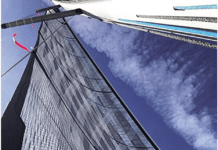California’s decision to ban sale or use of several chemicals found in marine products (above) is of interest to PS readers. After a careful review, we generally support this list, and we’re adding a few more we’ve found troublesome.
The California Association of RV Parks and Campgrounds has been working on this since about 2000, in an attempt to solve problems the members were having with ruined septic systems and contaminated ground water. After several failed attempts, a measure was passed in September 2019, with an effective date of 1-1-2022, that bans both the sale and use of holding tank treatments that contain formaldehyde, bronopol, gluteraldahyde, and eleven more chemicals that have proven damaging.
The first seven are anti-bacterials that interfere with septic tank treatment. The next six are solvents, added to clean grease build up from waste lines. They are toxic, difficult to degrade, and are persistent in groundwater. Ethylene glycol is sometimes added as antifreeze and has very high biological oxygen demand, overloading septic systems.
Chemical toilet treatments actually eat up the hoses at this portable toilet waste unloading station.
Perhaps you think you do not discharge into a septic tank. In fact, at some small marina pump-outs you may. And there are other reasons to avoid these chemicals. Practical Sailor testing (see PS February and December 2012) has shown that the best way to minimize holding tank odors and reduce pump-out issues is to maintain a healthy aerobic bacterial culture in the tank, by providing ventilation, using holding tank treatments that augment nature, and by not poisoning the bugs. These chemicals are also generally rough on elastomers and hoses. They may claim to be safe, but more likely they are doing slow damage to hoses and joker valves, increasing permeation and shortening their lives.
Even large public treatment works often refuse chemical toilet waste based on bad experiences with treatment chemicals inhibiting waste treatment and causing upsets. Generally, marina pumpouts must go to a holding tank and be sent out for treatment, rather than discharged into the sewer. Finally, the solvents will either evaporate and become hazardous air pollutants or pass right through the treatment system. Contrary to labeling claims, most of these are very difficult to degrade.
The private treatment plant above accepts as many as 20 tankers per day of chemical toilet waste that the city refuses. The anti-bacterial agents were causing violations at the public treatment plants.
How am I so certain of this? When I’m not sailing I do engineering consulting work, and a recent project involved operational difficulties at an industrial wastewater plant that was accepting large volumes of chemical toilet waste. The city wised up and stopped accepting this chemical soup. The private plant (above) can treat the waste by the using pretreatments that would be impractical if applied to their entire sewer volume.
Related post: “Cleaning Up Spring Cleaning“






































Thanks Drew for a very informative article. At the Longbranch Marina in Puget Sound we are in the process of setting up a pump out station for South Sound boaters. We have no municipal sewer system and the waste will need to be either hauled off or a septic system built. Our concerns, especially after reading your article, are with salt water and deodorizers in the effluents. Will these kill the bacteria in a septic system leaving no alternative but to have the waste trucked off?
Thanks
A septic system must be designed to handle the projected number of pump-outs. Needless to say, this will be considerably larger than a home system, but it is a common solution for small businesses in rural areas, such as truck stops. The septic designer will need to understand that the BOD will be 5-10 higher than ordinary sewage, because the flush water volume is much lower and there are no sinks or showers attached. Seawater inhibits bacterial activity if over about 5% of the flow and it will, over time, kill the grass and poison the drain field. You could prohibit flushing with seawater, although enforcement will be problematic (many sailors flush with freshwater to reduce odors and hose scale problems). Antiseptic head additives are also a serious problem if boaters using these exceed about 5% of users. Formaldehyde, bronopol, and other quaternary amines are the primary offenders. Nitrate and bug-based treatments are acceptable.
A package sewage treatment plant is another option. Basically a miniature version of a public treatment plant, they are not cheap and some operator attention is required. Discharge requirements can also be challenging. Finally, you can have the wastewater hauled off site. At least the cost is known and can be figured into the fees. This is common practice in many areas; the wastewater plant illustrated in the article is a private facility that accepts industrial wastewater, chemical toilet waste, and holding tank waste (marine and commercial). And sure enough, saltwater and formaldehyde are daily problems for them.
I’ve followed “Headmistress” Peggie Hall’s advice for years and only use bio-enzymatic cleaners and treatments. These environmentally friendly non-toxic and non-caustic products prevent raw water odor by enhancing the break-down of sewage and gray water via helpful enzymes and bacteria. I live on my 6 year-old boat full time ~5 months of the year and it still smells new. Why anyone would use chemicals that create smelly and toxic anaerobic cesspools which readily permeate sanitation hoses is beyond me. Every boat owner should have a copy of Hall’s book: Get Rid of Boat Odors : A Boat Owner’s Guide to Marine Sanitation Systems and Other Sources of Aggravation and Odor.